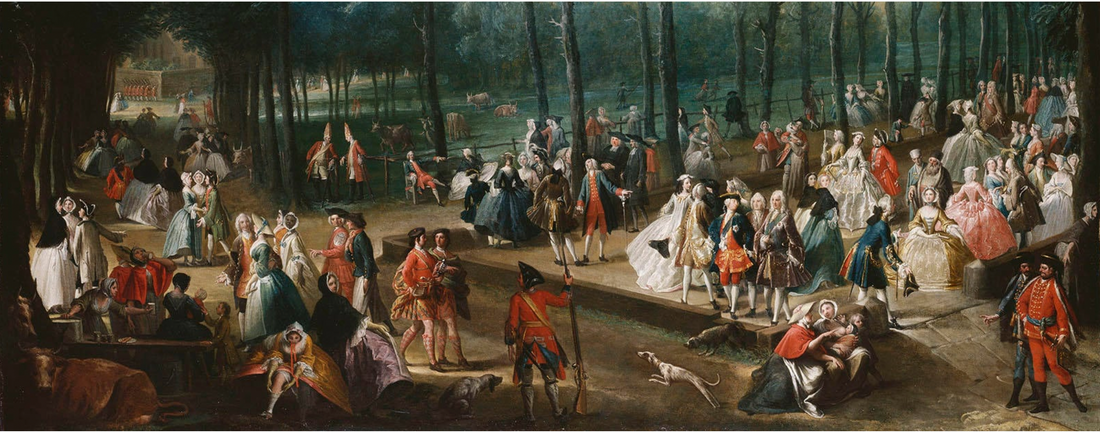
EARLIEST SURVIVING BRITISH ROYAL WEDDING DRESS
The wedding dress of George IV’s daughter Princess Charlotte of Wales, on display for the first time in over a decade, is among more than 200 works from the Royal Collection that go on show at The Queen’s Gallery, Buckingham Palace until Sunday 8 October 2023 in the new exhibition Style & Society: Dressing the Georgians.
The exhibition explores what fashion can tell us about life in Georgian Britain, a period rocked by social, political and technological revolutions. Alongside paintings, prints and drawings by artists such as Gainsborough, Zoffany and Hogarth are rare surviving examples of clothing, jewellery and accessories. Together, they provide a fascinating insight into what was worn across all levels of society, from the practical dress of laundry maids to the glittering gowns worn at court.

Image: Princess Charlotte's Wedding Dress. Front and back with train (RCIN 71997). Image courtesy of Royal Collection Trust.
Princess Charlotte was George IV’s only legitimate child, but died in childbirth at the age of 21 in 1817. Her marriage to Prince Leopold a year earlier was considered one of the most important royal weddings of the era. Her silk embroidered bridal gown is the only royal wedding dress that survives from the Georgian period, though it appears to have been significantly altered from its original form, in keeping with the Georgian practice of repurposing and recycling clothing. The Princess followed the tradition for European royal brides to wear silver, despite white wedding dresses becoming popular by the end of the 18th century.
Image:
Close up detail of the shell-ornamented borders of the sleeves (RCIN 71997).
Image courtesy of Royal Collection Trust.
Princess Charlotte’s mother, Caroline of Brunswick, also wore silver for her wedding to the future George IV in 1795. On display for the first time is a portrait of the wedding ceremony by John Graham, displayed alongside the original silver and gold dress samples supplied for the bride and other royal guests, on loan from Historic Royal Palaces. While the royal couple and their congregation made a glittering spectacle, their highly embellished clothing and wide skirts would have been noticeably outdated in fashionable circles, reflecting the increasing association of the court with old-fashioned styles of dress rather than cutting-edge trends.
Anna Reynolds, curator of Style & Society, said, ‘Dress is so much more than just what we see on the surface, and it’s fascinating what we can learn about a period when looking at it through a fashion history lens. Visitors might be surprised to learn how much the Georgian period has in common with the fashion landscape we know today, from influencers and fashion magazines to ideas about the value of clothes and how they can be recycled and repurposed.’

Image: Portrait of Queen Charlotte (1744-1818) c. 1781 by Thomas Gainsborough (1727-1728). Oil on canvas (238.8 x 158.7 cm). RCIN 401407. Image courtesy of Royal Collection Trust.
At the heart of the exhibition will be a full-length portrait by Thomas Gainsborough, c.1781, depicting Queen Charlotte wearing a magnificent court gown. It will be shown alongside a beautifully preserved gown of a similar style, worn at Queen Charlotte’s court in the 1760s, on loan from the Fashion Museum Bath. Portraits throughout the exhibition will demonstrate how artists rendered magnificent gowns such as these in paint in exquisite detail, from the metallic woven silk in Antoine Pesne’s Duchess of Saxe-Wessenfels, to the bows and fine lace of Francis Cotes’ Princess Louisa and Princess Caroline.
Image: Allan Ramsay, Queen Charlotte, c.1760–1.
Image courtesy of Royal Collection Trust.
Allan Ramsay’s life-size coronation portraits of George III and Queen Charlotte demonstrate how ceremonial clothing was carefully chosen to emphasise themes of continuity, tradition and spectacle. Queen Charlotte wears a gown heavily embroidered with gold thread, and a stomacher panel covered with diamonds.
With the rise of a professional class, more women earning wages, and cheaper fabrics available, the 18th century saw fashion becoming more accessible to the masses. Pleasure gardens, theatres and coffee houses provided new settings to show off the latest styles, and the first fashion periodicals spread up-to-the-minute trends, many inspired by clothing previously reserved for working-class or sporting pursuits. Pages from influential French fashion periodicals, on display for the first time, recommend looks inspired by men's riding dress and military uniforms, both of which became popular everyday styles for women.
The Georgian period saw specific forms of children’s clothing introduced, designed with comfort, practicality and freedom of movement in mind. In Benjamin West’s 1782 portrait of Prince Octavius, the 13th child of George III and Queen Charlotte, the three-year-old wears a skeleton suit – a new style of children’s dress inspired by the working-class clothing of sailors and fishermen. The young prince, perhaps playing at being king, is shown carrying his father’s sword, which will be shown alongside the painting, both on public display for the first time.
Style & Society: Dressing the Georgians is on show at the The Queen’s Gallery, Buckingham Palace until Sunday 8 October 2023.
